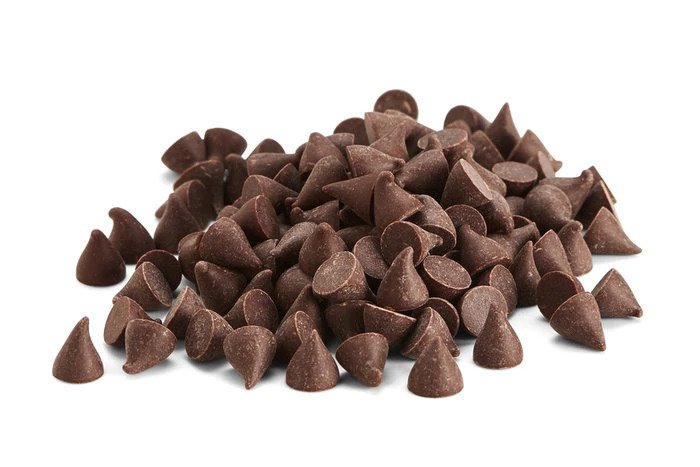Why Chocolate Chips Are Mostly Used for Ice-Cream Topping

Little pieces of sweetened chocolate known as chocolate chips or chocolate morsels are employed as a component in a variety of sweets, most notably chocolate chip cookies and muffins, trail mix, and far less frequently in some breakfast items like pancakes. Some other type of chocolate chip has the shape of a block or a rectangle; these are frequently produced as teardrop-shaped volumes with flat circular bases. They come in a variety of sizes, with a typical diameter of fewer than 10 millimetres (0.39 in).
The Reasons Why Chocolate Chips Are Mostly Used
Several frozen uses call for “chocolate-flavoured” ingredients instead of actual chocolate chips. The incredible melting characteristic of cocoa butter, which causes chocolate to melt in your mouth rather than your Tongue, is what makes it melt in your mouth. Since different fatty acids make up all fatty meals, their melting points vary depending on the temperature at which they are consumed. As the butter melts on a hot day, there is usually a pool of fluid (the longest, most unsaturated fatty acids, with the highest melting temperatures) and some soft, solid butter (the longer ones), which is still keeping its shape. The differing melting points of the fatty acids that compose the butter are represented by these 2 stages. The way cocoa butter acts varies. Consider instances where chocolate appears firm but then is quite mushy.
Despite being perilously close to melting, it has not yet begun to trickle or collect in this instance. Real chocolate melts all at once, enhancing the melting experience, which is why it is so fantastic and enjoyable. Real chocolate that has been frozen considerably ruins the melting process. This sensation is seriously ruined by putting it in ice cream. It will require a while for frozen chocolate chips to warm up and melt in your mouth because they are so cold.
Brittle and Chalky
They may initially feel chalky, but if you’ve got a lovely warm mouth, they would ultimately melt and give you that wonderful experience. Your lips won’t be heated enough just to melt such chips whenever you eat an ice cream cone. Most individuals won’t wait until the ice cream is gone before eating them since it will feel gritty and take a long time to melt. They will break whenever you bite into them, and they’ll also taste and feel unpleasant. They would be brittle and chalky. Thus, a company that produces ingredients recognised there was a demand for chocolate chips for particular frozen uses. They added some fats and oils with lower melting points to their products to address this issue.
They may have previously been hydrogenated vegetable oils, but they are now more likely to be palm oil or fractionated (by melting temperature) palm. If it’s any solace, oils with lower melting points are generally more nutritious. They’ve created a chip that, since it melts at a lower temperature than chocolate, behaves something like chocolate whenever you consume it with an ice-cream-filled, fairly cold tongue.
Fortunately, there’s a person out there guarding against food fraud. Government-enforced food regulations are present in many nations. In essence, these conditions must be satisfied before you may use a term like Chocolate, Bacon, Fruit Juice, etc.
Since these items no longer contain >35% cocoa solids after the sugar and other oils, these are probably not in compliance with the Chocolate standard. After that, it’s simply up to the company producing them to select a truthful title for their good. There they are chocolate-flavoured chips. The fluid used to dip cones at Dairy Queen and the majority of other frozen chocolate you see in conventionally made ice cream products fall under this category as well.
Types
Semi-sweet chocolate was primarily used to make chocolate chips, however, there are now numerous tastes available. These consist of bittersweet, peanut butter, butterscotch, mint, white, dark, & milk chocolate, as well as chips with white and dark swirls.
Uses
Cookies, pancakes, waffles, cakes, pudding, muffins, crêpes, pies, hot chocolate, as well as a variety of pastries may all be made with chocolate chips. They can also be discovered in an array of other commercial food items, including trail mix, ice cream, & granola bars.
Melting and Baking
Melted chocolate chips may be incorporated into sauces and other dishes. Temperatures around 104 and 113 °F (40 and 45 °C) are ideal for the chips’ melting point. At 90 °F (32 °C), whenever the cocoa butter in the chips begins to melt, the melting program commences. With milk chocolate, white chocolate, and black chocolate, the cooking temperature should never be higher than 115 °F (46 °C) or 120 °F (49 °C), respectively. Otherwise, the chocolate would burn. Melted chocolate chips are easy, but they shouldn’t constantly be used in place of baking. Usually, chocolate chips include less cocoa butter than baking chocolate since they are made to hold their shape while baking, which makes them more challenging to deal with when melted.
Final Words
In conclusion, there are several reasons why chocolate chips are a popular ice cream topping. These are the ideal size and shape for scattering on top of ice cream since they melt just a little bit when they come into touch with the icy treat, creating a delectable texture difference. There are many different types of chocolate chips, from traditional milk chocolate to more unusual combinations like dark chocolate and sea salt or white chocolate and macadamia nuts. Ultimately, chocolate chips are a go-to option for anyone wishing to add a little more to their ice cream due to their simplicity and adaptability.